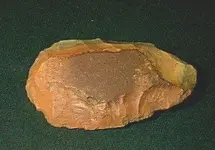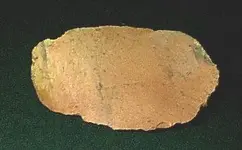Nice like end scraper. I don't believe it's paleo, due to the fact that it appears to be made out of heated Kay Co. (florence A) chert. Also....scrapers / tools like that were made in all time periods. About the only way to tell for sure if one is Paleo, is to find it in direct association with other paleo items. Here are some common misconceptions about scrapers:
"It's oblique parallel flaked, that's paleo flaking" - Not so. The finest worked scrapers are without a doubt Hopewell, who also practiced core technology. Their scrapers can commonly be found with super symmetrical Parallel, Oblique Parallel, or even transverse flaking.
"Paleo are the only scrapers that have the bulb trimmed". Not true. Many historical cultures often trimmed the bulbs on their scrapers....they also often employed graver spurs on the ends.
"It's large & crude, so it had to just be a scraper or butchering tool". - As any knapper can tell you, not all material is suitable for knapping. Many of what you find are simply discarded items that were "tested" during quarrying and found to be unsuitable. After some whacks you can often find a hidden flaw that you know wouldn't be easy to deal with...so it's simply easier to toss it and find another.
"Oklahoma has the sexiest fuzzy men". - This of course is entirely true.
Turtleback scrapers are named so because they resemble a turtle shell. They are a uniface with a domed profile and are round.
Duckbill scrapers are named so because they resemble a duck's bill. They can attain good lengths, are rectangular, with the Distal end being steeply beveled with pressure flaking.
Thumbnail scrapers are named so because they resemble a human fingernail. They are generally short and stubby, often square'ish' and the distal end is steeply beveled with pressure flaking. Duckbill scrapers after several resharpenings can resemble a thumbnail scraper.
Ok...I've typed my novel for the day and I have Taco Bell burritos waiting on me.




 RR
RR